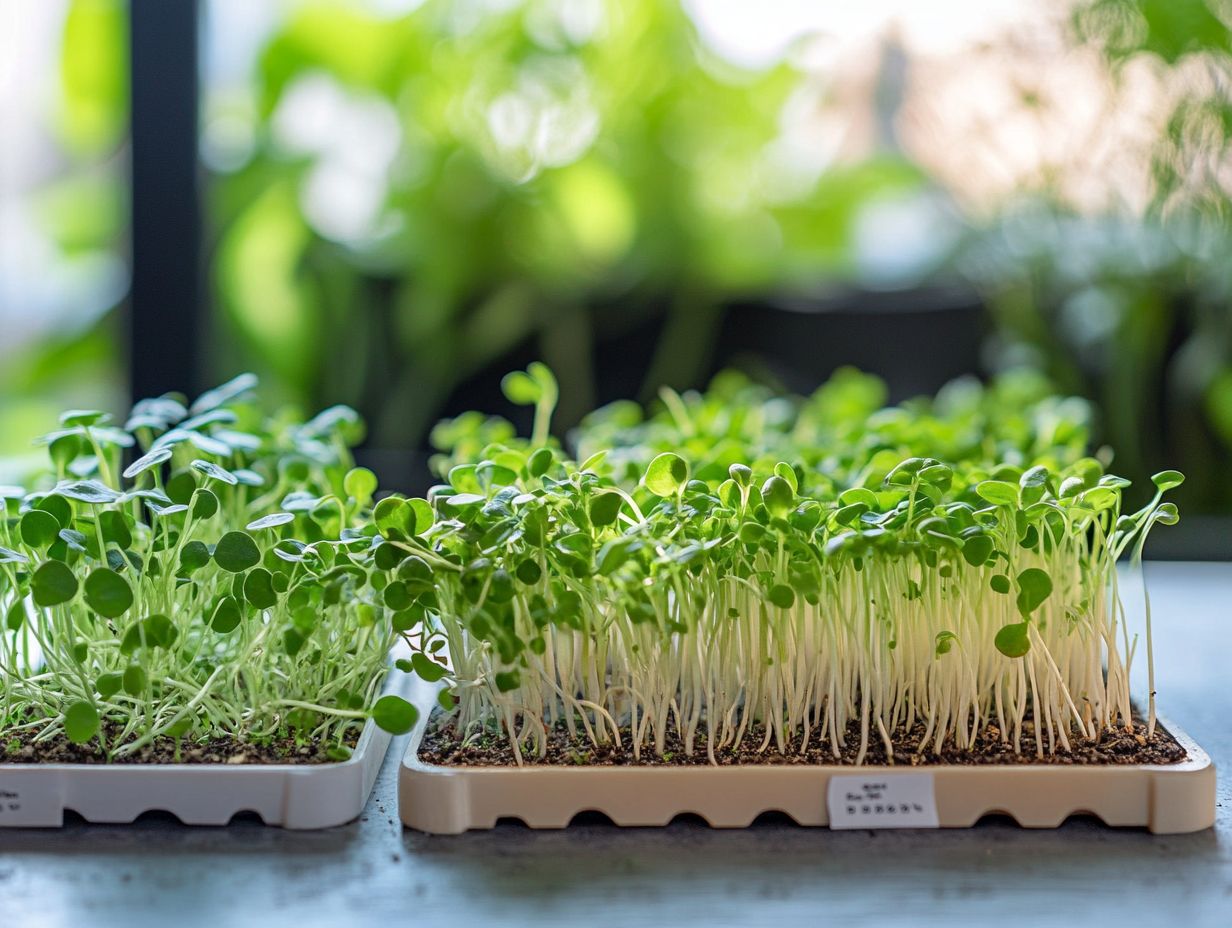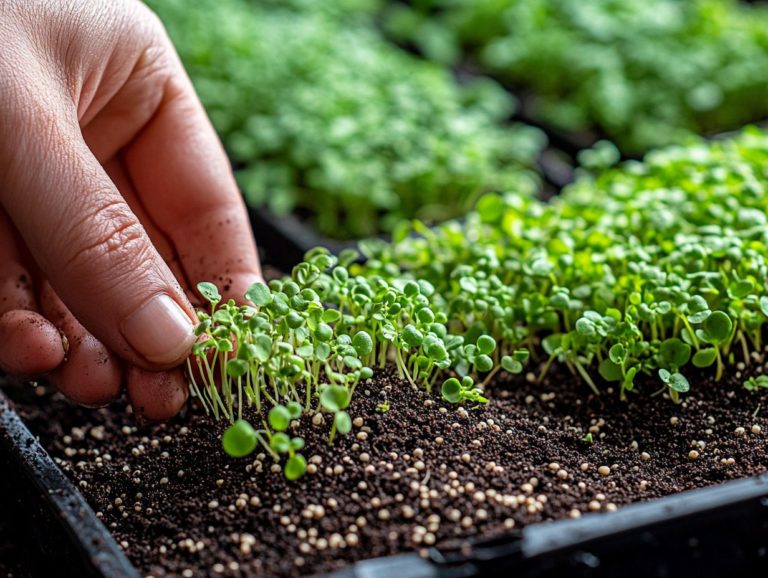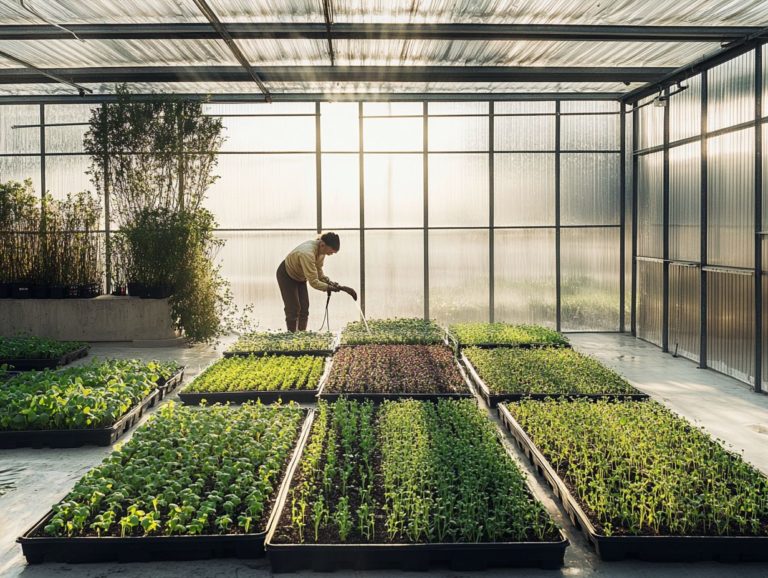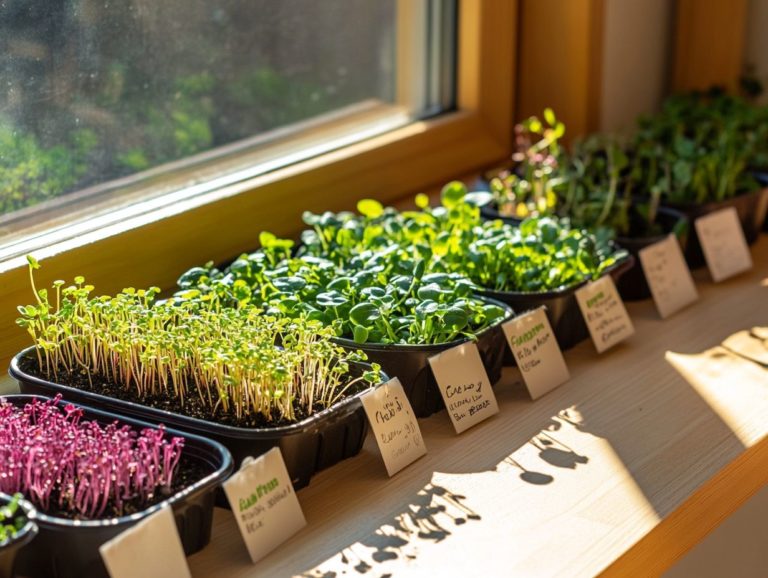Top 5 Mistakes in Growing Microgreens
Growing microgreens is not only a rewarding endeavor but also a nutrient-rich one. However, as a beginner, you might encounter pitfalls that could impede your journey.
Choosing the wrong seeds or mismanaging light and water can transform what should be a promising garden into a frustrating experience. Let s explore the five common mistakes you should avoid when growing microgreens, alongside essential tips for fostering thriving growth, highlighting their health benefits and exploring their creative culinary applications.
Discover the secrets to growing amazing microgreens.
Contents
- Key Takeaways:
- 1. Choosing the Wrong Seeds
- 2. Using Poor Quality Soil
- 3. Over or Underwatering
- 4. Not Providing Enough Light
- 5. Not Harvesting at the Right Time
- What Are Microgreens and Why Are They Popular?
- What Are the Health Benefits of Microgreens?
- What Are the Most Common Types of Microgreens?
- What Are the Best Growing Conditions for Microgreens?
- How Can One Avoid Common Mistakes in Growing Microgreens?
- What Are Some Tips for Growing Microgreens Successfully?
- How Can You Incorporate Microgreens into Your Diet?
- What Are the Different Ways to Use Microgreens in Cooking?
- How Can You Store and Preserve Microgreens?
- What Are Some Fun Facts About Microgreens?
- Frequently Asked Questions
Key Takeaways:

- Choosing the right seeds, such as organic seeds, non-GMO seeds, and pathogen-tested seeds, is crucial for successful microgreen growth. Research and select seeds that are specifically labeled for microgreen production.
- The quality of soil used for microgreens greatly affects their growth. Use a high-quality potting mix or make your own with equal parts compost, peat moss, and vermiculite.
- Proper watering is essential for microgreens. Avoid over or underwatering by monitoring the moisture level of the soil and using a misting bottle to evenly water the seeds.
1. Choosing the Wrong Seeds
Choosing the right seeds is absolutely essential for your journey of growing microgreens. Opting for organic, non-GMO, and pathogen-tested seeds can greatly influence early germination and the overall health of your crops, helping you sidestep those common home gardening pitfalls.
You can choose from seeds like radish, broccoli, and sunflower that deliver distinct flavors and impressive nutritional benefits perfect for microgreens. It s crucial to prioritize the quality of your seeds, as this ensures your plants retain their desirable characteristics throughout their growth cycle.
Knowing how many seeds to plant helps you grow vibrant microgreens. Utilizing a seed calculator a tool to help you figure out how many seeds to plant for the best results can guide you in determining the optimal number of seeds to plant per tray, encouraging healthy competition among seedlings while maximizing yield. This thoughtful approach helps avoid overcrowding and ultimately paves the way for a bountiful harvest.
2. Using Poor Quality Soil
Using poor soil can harm your plants, stunting their growth and stopping your microgreens from growing well. That s why selecting a sterile growing medium, like coconut coir, is essential for ensuring optimal moisture retention and encouraging robust root development.
A high-quality growing medium should provide not only excellent drainage but also the ability to retain sufficient moisture, guaranteeing that your young seedlings consistently have access to water. Coconut coir truly shines in this regard; it s lightweight, sustainable, and packed with natural nutrients, creating an ideal environment for vibrant growth.
The quality of your soil is important for keeping moisture levels right. If the medium dries out too quickly or becomes overly saturated, it can negatively impact root development. By choosing a balanced growing medium, you set the stage for microgreens to thrive, establishing a strong foundation for healthy plants poised to reach their full potential.
3. Over or Underwatering
Finding the perfect balance when watering is essential for maintaining healthy microgreens. Both overwatering and underwatering can lead to pesky problems like mold growth and contamination, ultimately jeopardizing your harvest.
It’s vital to recognize the signs of these issues. Overwatering typically shows up as yellowing leaves or a soggy growing medium, leading to underdeveloped plants, while underwatering may present itself with wilting leaves and crispy edges.
The quality of your water is equally important; using chlorinated tap water can impact plant health just as much as unpredictable watering habits.
To stay ahead of these challenges, you ll want to keep a close eye on moisture levels. Utilizing a moisture meter or simply checking the top inch of soil can effectively indicate when your microgreens need a drink, ensuring they get just the right amount of moisture for optimal growth.
4. Not Providing Enough Light
Insufficient light can significantly hinder the growth of microgreens. It’s crucial to understand their specific light requirements and invest in high-quality grow lights that ensure even light distribution for robust development.
Each variety of microgreen comes with unique needs. For instance, leafy greens generally thrive in brighter conditions, while others can flourish in lower light levels. This variety shows why you must tailor your lighting setup!
The positioning of your grow lights is vital for maximizing exposure. Ideally, place the lights at a height that provides uniform illumination to all seedlings, preventing any shading or uneven growth. Rotating your trays helps achieve even light distribution, fostering healthier plants.
5. Not Harvesting at the Right Time

Harvesting microgreens at the right time is essential for maximizing their nutritional benefits and flavor. Don t miss the perfect moment to harvest! Waiting too long risks a decline in quality, and you may need to replace crops to keep your garden healthy.
To recognize when these delicate greens are at their peak, keep a close watch. Most varieties are ready for harvest when they reach about 1 to 3 inches in height and showcase a vibrant color, indicating robust growth. The first true leaves, known as cotyledons (the first leaves that appear after germination), serve as a key indicator of readiness.
Harvesting at this precise moment preserves the taste and essential nutrients, ensuring a more steady harvest over time, and minimizing waste while enhancing your overall satisfaction in the growing process.
What Are Microgreens and Why Are They Popular?
Microgreens are young, edible plants bursting with flavor and nutrients. They re gaining traction among health-conscious consumers and indoor gardening enthusiasts eager to elevate their diets with fresh nutrition, whether cultivated indoors or on kitchen counters.
These diminutive greens are harvested at a delicate stage, just after the first true leaves emerge. They showcase a concentration of vitamins, minerals, and antioxidants that often surpass their mature counterparts. Their vibrant hues and bold flavors add an artistic flair to salads, sandwiches, and garnishes, captivating both chefs and home cooks alike.
The simplicity of growing microgreens allows you to experiment with a variety of them, catering to diverse dietary preferences, including vegan, gluten-free, or keto diets. This accessibility fosters healthy eating habits and cultivates the joy of nurturing plants from the comfort of your own kitchen.
What Are the Health Benefits of Microgreens?
The health benefits of microgreens are remarkable. They are packed with vitamins, minerals, and antioxidants, providing a concentrated source of fresh nutrition that can elevate your overall well-being.
These tiny powerhouses, including varieties like broccoli, kale, and radish, boast impressive levels of essential nutrients such as vitamin C, vitamin K, and polyphenols. A study published in the *Journal of Agricultural and Food Chemistry* revealed that microgreens can contain up to 40 times more vitamins than their mature counterparts.
Incorporating these vibrant greens into your meals not only enhances flavor but also supports improved heart health, a stronger immune system, and reduced inflammation. Their nutrient density makes them excellent additions to any balanced diet, allowing you to maximize your health benefits effortlessly.
Start your microgreen journey today!
What Are the Most Common Types of Microgreens?
You ll find several popular types of microgreens, such as arugula, basil, and radish. Each offers distinct flavors and impressive nutritional profiles. They are often grown from organic or non-GMO seeds. These tiny greens are far more than just delicate garnishes; they bring a robust burst of taste and numerous health benefits.
Take arugula, for example it delivers a delightful peppery zest that elevates salads and sandwiches. Basil, with its aromatic sweetness, is a staple in Italian cuisine and pesto. Radish microgreens, boasting a crisp, spicy bite, can truly invigorate your stir-fries or tacos.
Beyond their flavor, these greens are nutritional powerhouses, loaded with vitamins A, C, and K, alongside essential minerals and antioxidants. To achieve optimal growth and flavor intensity, it s vital to source high-quality seeds that are free from contaminants. Get ready for a bountiful and vibrant harvest that will amaze you!
What Are the Best Growing Conditions for Microgreens?
To successfully grow microgreens, it s essential to grasp their optimal growing conditions. These include adequate light, proper moisture retention, and sufficient airflow and ventilation to prevent undesirable issues like mold growth.
Creating a warm environment with temperatures between 60 F and 75 F lays the groundwork for robust growth. Light is critical; ensuring your microgreens receive a minimum of 12 to 16 hours of bright, indirect sunlight or artificial light will significantly boost their development. Additionally, avoiding the top mistakes in microgreen equipment choices can further enhance your growing success.
Maintaining consistent moisture levels is vital aim for a balance that avoids both sogginess and dryness. Microgreens thrive in well-draining soil with a slightly damp surface. For enhanced air circulation, consider using shelves or spaced-out trays to reduce humidity accumulation.
By implementing these strategies, you can cultivate a thriving microgreens setup that caters to various growing preferences.
How Can One Avoid Common Mistakes in Growing Microgreens?

Avoiding common mistakes in growing microgreens is essential for achieving a healthy harvest. Using tools like a seed calculator a tool that helps you find the right number of seeds to plant can greatly enhance your gardening practices and help you track growth effectively.
Often, these mistakes arise from overwatering or improper lighting conditions, leading to stunted growth or even mold development. It’s crucial to monitor moisture levels consistently, ensuring your microgreens neither dry out nor become waterlogged. If you encounter issues, check out troubleshooting common microgreen growth issues for helpful tips.
Planting density is another important factor; cramming too many seeds into one area creates fierce competition for nutrients. A seed calculator can be invaluable in determining the right quantity of seeds, allowing for even and optimal distribution.
Regularly inspecting plant health and adjusting light exposure will also help prevent common diseases, ensuring your microgreen garden thrives beautifully.
What Are Some Tips for Growing Microgreens Successfully?
Growing microgreens successfully requires mastering a blend of techniques that cater to their specific needs. Meeting their light requirements is crucial; ensure they bask in 12-16 hours of adequate sunlight daily to develop those vibrant leaves.
Keep a close eye on moisture levels; a gentle mist from a spray bottle can keep the soil just right without drowning it. Remember, optimal air flow is essential as well stagnant air invites mold and pests, and we definitely don t want that.
If you spot any pesky insects or mold making an unwelcome appearance, address these issues promptly. Using natural pest repellents or tweaking your watering schedule can significantly enhance your microgreen garden s health and vitality.
Start your microgreens journey today! Share your experiences and tips with fellow gardening enthusiasts!
How Can You Incorporate Microgreens into Your Diet?
Incorporating microgreens into your diet is not only easy but also highly rewarding. These healthy greens can enhance the flavor and nutritional profile of many dishes, from vibrant salads to refreshing smoothies.
These tiny plants are packed with essential vitamins and antioxidants, providing a delightful crunch and a burst of flavor that elevates your meals. For example, a handful of spicy radish microgreens can transform a simple sandwich, while delicate pea shoots add sweetness to stir-fries and grain bowls.
They’re incredibly easy to grow at home, making them an accessible choice for anyone looking to improve their cooking skills. Toss them into omelets for an extra kick or blend them into dressing for a nutrient boost; the possibilities are endless.
What Are the Different Ways to Use Microgreens in Cooking?
Microgreens offer numerous culinary opportunities, serving as vibrant garnishes, flavorful additions to salads, or even as star ingredients in your dishes. They are a versatile choice for enhancing both nutrition and taste.
Consider adding a mix of these tiny greens to your next salad for a delightful burst of color and flavor. They elevate simple greens and add complexity to sandwiches, easily replacing lettuce or providing a surprising crunch in wraps.
When blended into dressings, microgreens also add a unique and refreshing twist. For entrees, they shine atop grilled fish or chicken, acting as both a visual garnish and a nutritious boost.
By experimenting with different varieties, you ll discover how each type complements various cuisines, offering endless possibilities for creative and healthy meals.
How Can You Store and Preserve Microgreens?
To keep your microgreens fresh and nutrient-rich, using the right storage techniques is crucial, whether you choose to use your refrigerator or methods to extend their quality over time.
A highly effective method is to store them in breathable containers, like perforated plastic bags or clamshells, which allow for optimal airflow. Maintain a cool temperature, ideally between 34 F and 40 F, to minimize wilting and spoilage. Handle microgreens with care during storage to prevent bruising.
For added shelf life, consider placing a damp paper towel inside the container to maintain humidity without creating excess moisture. By following these straightforward practices, you can ensure that the vibrant flavors and nutrients of your microgreens stay intact, especially when using the top pest control supplies for microgreens.
What Are Some Fun Facts About Microgreens?

Microgreens are not just nutritious; they also have some fascinating traits. For instance, they germinate faster than their mature counterparts and can thrive in various environments, truly making them a gardener s delight.
These young plants are harvested just after the first true leaves appear, delivering a burst of flavor that enhances any dish. You’ll find an impressive variety, from the spicy kick of radish to the delicate notes of basil, each contributing unique taste and texture.
Culturally, microgreens have gained attention from chefs and home cooks, celebrated for their vibrant colors and impressive nutritional benefits. They often grace the menus of upscale restaurants and farm-to-table eateries, adding elegance to any dining experience.
With their ease of cultivation, microgreens have become popular among urban gardeners, allowing you to enjoy fresh produce even in limited spaces.
Frequently Asked Questions
What Are the Top 5 Mistakes to Avoid When Growing Microgreens?
- Not using quality soil
- Over or under-watering
- Not providing enough light
- Overcrowding
- Not properly sanitizing equipment
Don t miss out on the incredible benefits of microgreens! Start growing or using them in your meals today!
How can poor quality soil affect microgreens?
Poor quality soil leads to stunted growth and nutrient deficiencies. Your microgreens may also become more vulnerable to pests and diseases.
What happens with over or under-watering microgreens?
Over or under-watering can cause wilting or discoloration. Consistent watering is key; never let the soil dry out completely.
Why is light important for microgreens?
Microgreens need enough light for proper growth. Without it, they can become weak or fail to grow altogether.
How does overcrowding impact microgreens?
Overcrowding creates competition for water and nutrients. This leads to smaller, weaker microgreens and increases the risk of pests and diseases.
Why should you sanitize equipment for microgreens?
Sanitizing tools prevents harmful bacteria and fungi from damaging your microgreens. Regularly clean and disinfect all equipment to ensure healthy growth.






